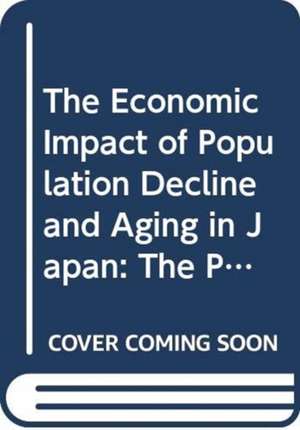The Economic Impact of Population Decline and Aging in Japan: The Post-Demographic Transition Phase: SpringerBriefs in Population Studies
Autor Kohei Wadaen Limba Engleză Paperback – 23 dec 2024
Din seria SpringerBriefs in Population Studies
-
 Preț: 344.90 lei
Preț: 344.90 lei -
 Preț: 177.49 lei
Preț: 177.49 lei -
 Preț: 355.53 lei
Preț: 355.53 lei - 15%
 Preț: 463.68 lei
Preț: 463.68 lei - 15%
 Preț: 463.03 lei
Preț: 463.03 lei -
 Preț: 442.62 lei
Preț: 442.62 lei -
 Preț: 414.42 lei
Preț: 414.42 lei -
 Preț: 377.57 lei
Preț: 377.57 lei -
 Preț: 476.57 lei
Preț: 476.57 lei -
 Preț: 376.80 lei
Preț: 376.80 lei -
 Preț: 205.29 lei
Preț: 205.29 lei -
 Preț: 376.22 lei
Preț: 376.22 lei -
 Preț: 377.73 lei
Preț: 377.73 lei -
 Preț: 477.17 lei
Preț: 477.17 lei -
 Preț: 379.09 lei
Preț: 379.09 lei -
 Preț: 346.66 lei
Preț: 346.66 lei -
 Preț: 380.07 lei
Preț: 380.07 lei -
 Preț: 343.88 lei
Preț: 343.88 lei -
 Preț: 343.39 lei
Preț: 343.39 lei -
 Preț: 374.46 lei
Preț: 374.46 lei -
 Preț: 375.23 lei
Preț: 375.23 lei -
 Preț: 378.92 lei
Preț: 378.92 lei -
 Preț: 378.34 lei
Preț: 378.34 lei -
 Preț: 474.84 lei
Preț: 474.84 lei -
 Preț: 376.59 lei
Preț: 376.59 lei -
 Preț: 476.42 lei
Preț: 476.42 lei -
 Preț: 379.09 lei
Preț: 379.09 lei -
 Preț: 476.79 lei
Preț: 476.79 lei -
 Preț: 441.85 lei
Preț: 441.85 lei - 15%
 Preț: 461.73 lei
Preț: 461.73 lei -
 Preț: 375.23 lei
Preț: 375.23 lei -
 Preț: 259.96 lei
Preț: 259.96 lei -
 Preț: 343.88 lei
Preț: 343.88 lei -
 Preț: 442.62 lei
Preț: 442.62 lei -
 Preț: 474.67 lei
Preț: 474.67 lei -
 Preț: 443.75 lei
Preț: 443.75 lei -
 Preț: 443.00 lei
Preț: 443.00 lei -
 Preț: 262.09 lei
Preț: 262.09 lei -
 Preț: 376.80 lei
Preț: 376.80 lei -
 Preț: 377.18 lei
Preț: 377.18 lei -
 Preț: 311.91 lei
Preț: 311.91 lei -
 Preț: 379.09 lei
Preț: 379.09 lei -
 Preț: 477.72 lei
Preț: 477.72 lei -
 Preț: 174.62 lei
Preț: 174.62 lei -
 Preț: 477.17 lei
Preț: 477.17 lei -
 Preț: 340.45 lei
Preț: 340.45 lei -
 Preț: 374.85 lei
Preț: 374.85 lei -
 Preț: 475.22 lei
Preț: 475.22 lei
Preț: 275.59 lei
Preț vechi: 355.87 lei
-23% Nou
Puncte Express: 413
Preț estimativ în valută:
52.75€ • 54.86$ • 44.20£
52.75€ • 54.86$ • 44.20£
Carte nepublicată încă
Doresc să fiu notificat când acest titlu va fi disponibil:
Se trimite...
Preluare comenzi: 021 569.72.76
Specificații
ISBN-13: 9784431548300
ISBN-10: 4431548300
Pagini: 100
Ilustrații: IV, 100 p. 20 illus.
Dimensiuni: 155 x 235 mm
Ediția:1st ed. 2024
Editura: Springer
Colecția Springer
Seriile SpringerBriefs in Population Studies, Population Studies of Japan
Locul publicării:Tokyo, Japan
ISBN-10: 4431548300
Pagini: 100
Ilustrații: IV, 100 p. 20 illus.
Dimensiuni: 155 x 235 mm
Ediția:1st ed. 2024
Editura: Springer
Colecția Springer
Seriile SpringerBriefs in Population Studies, Population Studies of Japan
Locul publicării:Tokyo, Japan
Public țintă
ResearchCuprins
1 Post-demographic transition 1.1 Ultra low fertility: Population have always had no ability to reproduce itself 1.2 Rise in life expectancy: To manage the risk of long life in super-aging society 1.3 Ageing and Population decline: The double wallop of the world’s fastest ageing and the first population dive in Japanese history.- 2 Impact to the supply side 2.1 Labor: The absolute shortage of domestic labor and the large inflows of immigrants 2.2 Capital: Will the national wealth of Japan shrink, too? 2.3 Technical progress: Expected to be the most powerful engine of economic growth.- 3 Impact to the demand side 3.1 Consumption : The fact is that older consumer demand is fairly strong 3.2 Savings: After all, which is true, the life cycle hypothesis or the dynasty model? 3.3 Investment: it depends on the young entrepreneurial business mind.- 4 Remedy for Japan 4.1 Population policy : The power of Asian local communities should raise the fertility in the long term 4.2 Economic policy : The design of universally worker-friendly workplace, the improvement in older consumer confidence and the fosterage of new industries appropriate to small population and small national land 4.3 Prospects for economic and population growth : Japan has the potential to grow unless policies are mistaken.
Caracteristici
Explains the economy of Japan as inextricably linked to the nation’s population in the post-demographic transition Makes the recent demographic and economic situation in Japan accessible for an English-speaking readership Emphasizes the power of local communities in East Asia in connection with economic and demographic policy for Japan
